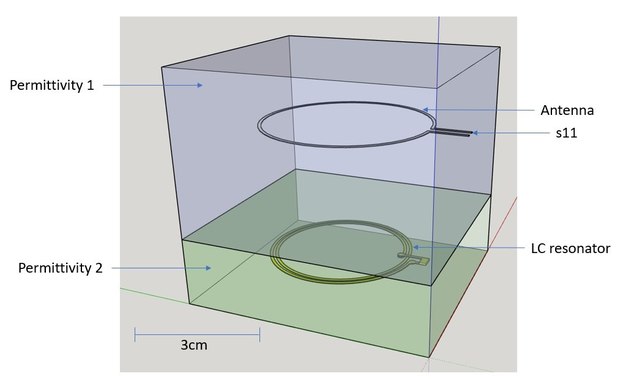-
 Isuru
0I am a beginner for the electromagnetic simulation software. I am referring to the attached picture.
Isuru
0I am a beginner for the electromagnetic simulation software. I am referring to the attached picture.
The green and blue boxes(areas) have different permittivities. The bottom box includes an LC resonator with a planar coil inductor and a parallel plate capacitor. The top box is an antenna. In real life, I am connecting the antenna to a network analyzer and measure the s11 response. I want to simulate this model in a simulation software. The result I need is the s11 plot of the antenna.
1) Can I use keysight ADS to do this simulation?
2) If (1) is a yes, can I import an autocad model to ADS and simulate?
Thanks in advance.

-
 madengr
1Yes, ADS, but I'll tell you in terms of Microwave Office, which is what I use. Much more integrated than ADS.
madengr
1Yes, ADS, but I'll tell you in terms of Microwave Office, which is what I use. Much more integrated than ADS.
I have done resonator measurements and simulation such as these, but typically you would use a two port (S21) measurement with two loop probes, as you will get much more dynamic range than a reflection measurement. You need very weak coupling to measure the unloaded Q of the resonator, and you probably won't get that with a 1 port measurement, and get an accurate measurement..
Your loop probes must be electrically small and operating below their self resonance, which it looks as if they are, given the geometry.
You haven't stated the boundary conditions; open or closed. Your say it is in a box, but I assume you mean embedded in a brick of dielectric, which has the sides open to free space, rather than in a conducting box.
So you can simulate it in 2.5D, which for MWO would be Axiem (the ADS equivalent is Momentum). You are on an infinite substrate, of multiple dielectric layers, with top and bottom boundaries. The boundaries can be open (sheet resistance of 377 Ohm/square), or conducting. You need to get the open boundaries 1/4 wavelength away (i.e. out of the reactive near field) from you circuitry. This looks to be a UHF resonator, so that can be quite far away, compared to the thin layer between the parallel plate capacitor. This is drastic size difference is not an issue for 2.5D simulator since you only mesh the conductors, not the volume, which is why you start there before moving to 3D. If you need conducting side boundaries, surround it with vias, but again, I assume this is open boundary. You would use differential ports (+/-) to drive the probe, or a gap port.
Another 2.5D in MWO is EMSight; ADS does not have an equivalent. Now you are in a box with conducting sidewalls, and can still set the top and bottom boundaries. Sonnet is very similar. The advantage is you get much more dynamic range with the closed boundary, but you are in a box. The mesh is also on a grid, whereas open boundary is gridless, though sonnet has some conformal meshing tricks.
For 3D, the MWO simulator is Analyst. The ADS equivalent is EMPro (I think). Now you can set arbitrary boundary conditions; open & short (E and H), and PML. You still need to get 1/4 wavelength away for open and PML, but not restricted to an infinite substrate. Though now you need to mesh the volume, including tiny volume between the capacitor plates.
If you are in a conducting box, you can use eigenmode analysis with Analyst, dispensing with the driven probes to solve the resonant modes within the box.
CST has a characteristic mode analysis, which I believe is an open boundary eigenmode analysis.
All of these programs support DXF import, though you ought to be re-drawing it in the native environment, so you can parameterize it. -
 Isuru
0Thank you loads for your time and i'm flabbergasted by your expertise B-).
Isuru
0Thank you loads for your time and i'm flabbergasted by your expertise B-).
"I assume you mean embedded in a brick of dielectric, which has the sides open to free space" your assumption is very accurate.
Let me slowly digest the fine details in your comment. And try to achieve my target, will further discuss if i get into trouble. Thanks again B-).
Welcome!
Join the international conversation on a broad range of microwave and RF topics. Learn about the latest developments in our industry, post questions for your peers to answer, and weigh in with some answers if you can!
Categories
- About Our Site
- Antennas
- Applications
- Biological Effects and Applications
- Calculators
- Communications
- Computer Aided Design
- EDA Software
- Emerging Applications and Technology
- Employment
- Field Theory
- Filters and Passives
- General Questions
- High Power
- History
- MMIC and RFIC
- Packaging and Materials
- Radar
- Sources and Receivers
- Test and Measurement
More Discussions
- Terms of Service
- Useful Hints and Tips
- Sign In
- © 2025 Microwaves 101 Discussion Board


